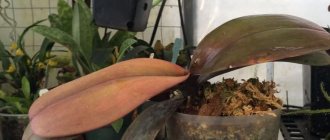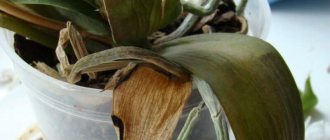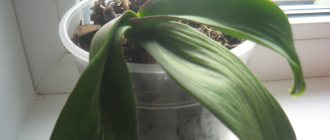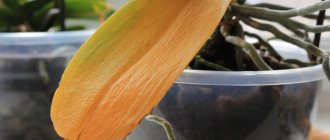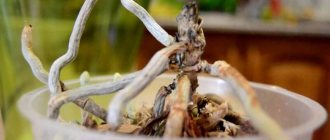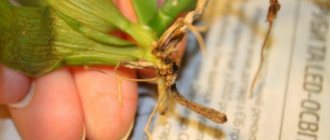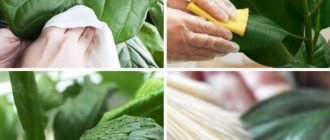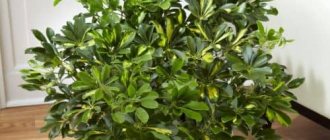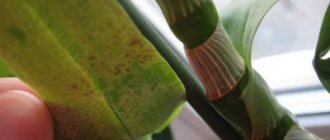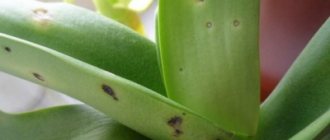I was inspired to write this article by the spring cleaning I did over the weekend. Our house is undergoing major renovations, after construction work a lot of dust is generated, and I have to constantly wipe it. Dust also collects on orchid leaves. Not only does it not look aesthetically pleasing, but it is also very harmful to not only our breathing, but also the breathing of orchids. I have allergies at home, so this summer my hobby is also almost daily wet cleaning. All surfaces have to be wiped quite often.
Why wipe leaves with polish?
The polish will cover the surface with a protective film and give the leaves shine and beauty . Its use does not exclude orchid care, which is always visible from the condition of the leaves.
The leaf skin is a special covering tissue that protects the internal tissues from :
- Drying;
- Various damages;
- Invasion of microorganisms.
Orchid polish is often used to wipe the leaves.
Despite the fact that after treating leaves with wax or oil polishes, a film forms on the surface of the leaf blade, the composition of commercial polishes is selected so as not to disrupt gas exchange in the leaf cells .
Important! By following the instructions, you will not harm the plant.
Terms of use
When using industrial polishes and homemade polishing compounds, there are precautions :
- Application is possible only for flowers that grow in diffused light or partial shade, as under the influence of direct sunlight the leaves can get a chemical burn;
- Before processing, contamination must be removed from the leaves;
- Only hard and leathery leaves, without lint and fluffiness, are treated with polishes;
- Rub only the outer part of the sheet. The reverse side of the leaf, stem and shoots are not wiped, as they must breathe;
- Do not apply polish to young, growing leaves, as this can lead to their death.
Since the plant may react negatively to the polishing agent, its effect is first tested on several leaves. The flower observation time for industrial polishes is two to three days, for home compositions – one week.
Application technology
Before applying the polishing agent, clean the leaves from dust using a damp cloth or sponge:
- Cleaning is carried out in the morning or afternoon so that the leaves are completely dry before evening;
- The sheet is cleaned both from the top and back sides;
- If the foliage is washed in the shower, then the substrate should be carefully covered with plastic wrap;
- In case of significant contamination, it is allowed to use foam from mild soap or shampoos, then rinse it thoroughly with clean water.
If after this the shine of the orchid leaves is not enough for you, then the next day you can apply polishing agents .
Water, folk remedies or polish: a checklist for the florist
To wipe leaf plates, flower growers use various compositions. To understand what is best to wipe the leaves of an orchid, you need to start from the condition of the flower and the desired result.
| How to wipe leaves | When to use | Result of application |
| Water | The surface of the leaves was covered with a dense dusty layer. | In an orchid with clean leaves, the process of photosynthesis and air exchange is accelerated. |
| Folk remedies | The leaves have an unsightly, emaciated appearance. | Prevents dust from settling, nourishes with vitamins and adds natural shine. The result largely depends on the chosen composition. |
| Polish | Even after removing dust, the leaf surface is not shiny enough. | An invisible protective film forms on the leaf. An additional effect is giving the phalaenopsis an attractive shine. |
Homemade ways to care for leaves
Long before the discovery of plant polishes, which are popular in our time, good housewives knew how to wipe the leaves of indoor flowers until they shine.
At home, you must remember to care for orchid leaves.
To do this, they used inexpensive natural ingredients and prepared the compositions themselves.
Advantages and disadvantages
The advantages of home polishes include :
- Ease of preparation;
- Natural ingredients;
- Shine of leaves after application of preparations.
But the disadvantages of home remedies, compared to industrial polishes, are much greater, as are the risks for plants. Home remedies are characterized by :
- Low efficiency;
- Unforeseen effects on the plant;
- Polishing leaves with homemade compounds takes a lot of time;
- The selection of ingredient ratios is a constant experimentation.
Carefully! If home remedies are not washed off, applied too often or in excess quantities, they will create an environment favorable for the proliferation of microorganisms and pests.
polish the leaves no more than once a month.
Norms for the use of funds
Recipes for homemade leaf polishes have been known for a long time and have a large number of admirers:
- Sugar syrup and honey. The leaves are wiped with sweetened boiled water of the following composition: four teaspoons of sugar or two teaspoons of honey, dissolved in 200 g of water;
- Lemon acid. After spraying with hard water, a limescale deposit appears on the leaves - the result of a large amount of salts in the water. It can be easily removed using a citric acid solution:
- 1/3 tsp. citric acid is diluted in one liter of water;
Instead of citric acid, you can dilute freshly squeezed pineapple or sour apple juice.
A solution made from natural products is not stored for a long time, is subject to rapid oxidation and darkens within a short time;
- Rubbing the leaves improves the appearance of the plant;
Strengthens the immune system;
Non-alcoholic beer contained in a polishing agent does not leave an odor in the room;
- Clogs the pores on the leaves;
Disrupts respiration in cells;
Leaves can be wiped with folk remedies.
Therefore, it is worth deciding what is more important - a healthy plant or temporary beauty;
- The thinnest film gives the leaves shine;
Protects the flower from the invasion of pathogenic bacteria and fungi;
Diluted milk creates a thin film around pests, which leads to their death;
How to save an orchid without roots. Orchid resuscitation.
The most unusual way to resuscitate a Phalaenopsis orchid is to grow roots from the neck of the plant in a vessel above water.
So, to resuscitate the Phalaenopsis orchid we will need:
- boiled chilled water,
- The upper part of the reanimated plant with a growing point is carefully cut off with a sharp, clean blade.
Before you begin rescue manipulations with our ward, you need to wait until the cutting site is a little delayed; for this, it is enough to leave the plant in a warm, shady place for several hours. If you notice symptoms of rot, treat with a fungicidal preparation, then dry.
Then pour boiled cooled water into a convenient vessel and place the plant above the water. It is advisable to place the container with the top part of the orchid under diffused lighting in a well-circulated warm place, the recommended temperature is 23-25°C.
Periodically, the orchid leaves should be wiped with a sponge soaked in a solution of succinic acid, this will help the weakened plant gain strength and energy. Or dilute the drug Doctor Foley vitamin (containing succinic acid) in a reduced concentration (three times) and treat the leaves.
Over time, the moisture in the vessel with the plant will evaporate, so you need to monitor this and add boiled water at room temperature as needed.
After two months, the roots of the reanimated Phalaenopsis will grow noticeably and as soon as they reach a length of 5-7 cm, the orchid can be transplanted into the substrate (photo No. 7).
It must be taken into account that in this case the plant has adapted to an unusual way of existence, so the soil must be selected accordingly. Based on personal experience, I would recommend planting the plant in sphagnum moss for the first few months. This type of moss has long been used as one of the main components of the substrate, and many orchid growers even grow most of their collection in it.
Industrial preparations that add shine
Wondering what to wipe the leaves with to make them shine? Polishes for obtaining gloss on leaves are available in the form of :
- Liquids;
- And aerosols.
According to their purpose, they are complex-action drugs with a wide spectrum of action.
Liquid polishes
Liquid polishes are used to manually polish large, leathery leaves, including orchid leaves.
Important! In order not to harm the leaves, industrial polishes for applying gloss to the leaves must be used strictly according to the instructions.
In specialized stores, liquid polishes are presented by manufacturers :
- "Doctor Foley";
- And "Clean Slate".
The advantages of industrial polishes include :
- Ease of use;
- Obtaining a spectacular, flawless shine;
- A protective barrier against pathogenic microorganisms and pests, which is created by a thin film on the surface of the leaves.
Flower growers often use liquid polishes.
Disadvantage: the oily or waxy film that forms on the leaves, in the case of frequent use of the drug, interferes with the breathing of the leaves and can cause more harm to the flower than a thick layer of dust.
Aerosols
Aerosols and sprays for leaf shine are intended for flowers with small, delicate or very dense foliage that is practically impossible to wipe by hand .
Products made with beeswax are very effective. They easily create a thin protective film that :
- Gives leaves gloss;
- Protects the plant from pathogens;
- It will reduce the release of liquid from the leaves, which is important when the humidity in the room is low.
Spray the aerosol onto the leaves from a distance of 30 cm.
However, such a spray has a big disadvantage - it clogs the pores of the leaves, which prevents their normal breathing. Therefore, it must be applied with caution and as rarely as possible, following all the rules described in the instructions.
Polishing aerosols are represented on the market by the following companies :
- Green house;
- And Perfect plant.
succinic acid
To maintain the beauty of the orchid, the leaves can be treated with a solution of succinic acid .
Without harming the orchid, this can be done once a week.
Attention! You should also not wet the cloth too much; excess succinic acid can cause burns.
It is also necessary to ensure that residual liquid does not accumulate in the axils of the leaves .
It is impossible to wipe orchids with succinic acid every day; even the most useful procedures can be harmful if carried out too often.
Treatment of leaves with succinic acid:
- Cellular metabolism is activated;
- The synthesis of chlorophyll is stimulated, which has a positive effect on : Plant health;
- The beauty and shine of the leaves.
Mode of application
Succinic acid is sold in the form of tablets and powder. The method of preparing the solution depends on this :
- One tablet is dissolved in 1 liter of water;
Some gardeners wipe orchid leaves with succinic acid. - 1 g of powdered acid is dissolved in 1 liter of water. In the absence of scales, the acid taken from the tip of a knife is dissolved in one liter of water.
Important! The resulting solution can be stored for no more than 3 days, after which a new one must be prepared.
Optimal wetting of leaves when watering
The structural features of orchid leaves are such that when water gets in, unsightly spots remain on the leaves. But it’s not just about the loss of decorativeness. The trouble is that when water accumulates in the mouths of leaves pressed tightly against each other, they begin to rot. If the process goes too far, the orchid may lose all its leaves. To prevent this from happening, you need to constantly check that moisture has not gotten into hard-to-reach places on the ground organs.
The accumulation of moisture in the axils of the leaves leads to their rotting.
Water collects in the sinuses if the orchid is watered carelessly. For irrigation, it is better to use watering cans with long, thin spouts. With their help, it is easy to direct the stream along the inner wall of the pot. This will prevent water from getting on the leaves.
Some gardeners practice bottom watering, which is called bathing.
- The pot with the orchid is immersed in a container of warm water. At the same time, carefully ensure that the leaves do not touch the water.
- Sometimes while bathing the plants are washed with a warm shower.
Important! After this procedure, the plates must be wiped with a soft cloth or paper napkin , which absorbs water well. Drops that get into the axils of the leaves must be removed using a cotton swab.
You don’t have to “rain” the orchid, but wipe the leaves with a cotton swab dipped in regular warm water.
They do this in order to wipe off dust from the plates. This is necessary not only for beauty, but for the normal respiratory process, without which all other vital functions of the plant are impossible.
Orchids are extremely sensitive to lack of air and require good aeration. Rubbing the leaves contributes to this phenomenon.
To prevent water from getting on the leaves of orchids, do not use a watering can with a scattering attachment for watering.
When wiping orchids, the quality of the water is of great importance. Use exclusively non-rigid, settled moisture. Often, the water that comes out of the tap contains a large amount of alkaline salts. After it, a thin coating remains, invisible to humans. It forms a thin film on the plates, which prevents the flow of air into the plant tissue. Sometimes so much salt accumulates that it forms a limescale deposit that is harmful to plants. That is why, for both watering and wiping, you need to use pre-prepared, non-hard water.
It is this that is used not only for irrigation, but also for foliar feeding of orchids.
Using a vitamin cocktail
You can improve your orchid’s health by spraying the leaves with a vitamin cocktail. It is prepared from a mixture of vitamins :
- IN 1;
- AT 6;
- B12 (one ampoule of each);
- Dissolved in 1 liter of water.
It is enough to spray the orchid leaves once or twice a month with this composition
Leaf feeding
In addition to root feeding, the orchid sometimes needs leaf vitamin nutritional supplements. They can be purchased at a regular pharmacy in the form of tablets or ampoules.
Vitamin feeding of leaves
Vitamin supplementation is especially important for weakened orchids with reduced immunity in order to stimulate the vitality of the flower.
A deficiency of certain vitamins can lead to:
- to loss of decorativeness;
- yellowing and wilting of leaves;
- lack of budding;
- stopping root growth.
It is important to correctly combine various vitamins with each other and use the resulting composition to wipe the leaves.
Basic recommendations for preparing vitamin supplements are presented in the table.
| Name | Required dosage | Required dosage |
| Vitamin B1 | 1 ml per 1 liter of water | Do not mix with other drugs. |
| Vitamin B3 | 1 amp. per 1 liter of liquid | It is most effective when combined with vitamins B6 and B12 in equal doses. |
| Vitamin B6 | 1 ml per 1 liter of liquid | As a rule, it is used together with vitamin B3. |
| Vitamin B12 | 1 amp. for 1 liter of water | Compatible with B3 vitamins. |
It is better to work with vitamin B1 in the evening. The components of the drug disintegrate in light, so the ampoules are made of darkened glass.
The procedure for feeding leaves with vitamins:
- Soak a cotton pad in the mixture and squeeze out.
- Wipe the leaves on both sides.
- The remaining solution can be poured into the pot.
To prevent weakened leaves, wipe them no more than once every 10 days. Healthy bushes with dense leaf blades should be treated less often.
Ready-made sprays with essential vitamins and minerals are available on the market:
- “Strong Leaf” TM Dr. Foley;
- “Tonic for orchids” TM Bona Forte.
After spraying the spray, protect the bush from the scorching sun to prevent thermal burns.
Use of succinic acid
Amber will help restore turgor to orchid leaves. A concentrated solution is suitable for wiping - 1 tablet per 250 ml of water.
The leaves should be wiped carefully, avoiding getting into the base of the bush. It is advisable to repeat the procedure for two days, and on the third, remove the remaining composition.
What should I wipe them with to make them shine?
The glossy dark green surface of large foliage is the main indicator of not only the health, but also the beauty of an indoor orchid. Unfortunately, not every amateur gardener can boast of the shiny surface of a plant. The absence of sunlight on the leaves does not indicate problems with the health of the orchid. Perhaps this effect is associated with the climatic conditions of a certain region or season. Therefore, in order to create such shine for greater beauty of the flower, you can use a special polish.
This product is made from natural ingredients and oils, so it is completely harmless. Applied to the surface of the leaf, it creates a thin film, which additionally makes the plant more resistant to drying out and the invasion of pathogens. It does not disrupt gas and water exchange, while allowing you to get beautiful highlights in the light. Before using the product for the first time, you must carefully study the instructions and follow a few simple rules.
- use polish only if the pot with the indoor beauty is not installed in a place accessible to direct sunlight. Otherwise, the risk that the tissues under the transparent film will suffer severe chemical burns is too great.
- The composition can only be applied to clean and dry leaves. Any dirt that ends up under the film will cause the orchid to become sick. In this case, only the outer surface of the sheet is covered, leaving its lower part untouched.
- Do not touch soft young leaves. You can often see online comments full of regret that after polishing, the orchid shed its leaves and died on its own. The main mistake was that the growers treated the orchid shoots that were growing too young. You can apply shine products only to large leathery leaves, which have already become quite tough. And so that the sheet does not break during the procedure, it must be gently held with an open palm from below.
In some cases, even strict adherence to all the rules can lead to the death of the plant. That is why the polish should first be tested on one piece of paper. If after 3-4 days there are no changes in the color and density of the tissues, you can cover all hard leaves with it.
What happens if orchid leaves are left dusty?
- Cellular respiration inside the leaf is disrupted
- Increases the possibility of getting sunburn on orchid leaves
- Photosynthesis slows down, resulting in the orchid receiving less nutrition.
- On unkempt leaves it is more difficult to recognize traces of pests, which tend to fly in from an open window in the summer.
In addition, wet cleaning of orchid leaves can be combined with foliar feeding. It is enough to add a few drops of succinic acid or a vitamin mixture (solution of B vitamins) to water. I use this technique often, especially on orchids that have few roots or leaves. Exact proportions: 1 ml of succinic acid per 1 liter of water. Of the ready-made solutions, I like Leaf Tonic from Bona Forte. After such care, leaves that have lost turgor are noticeably transformed. I know that some gardeners do preventive treatments against pests in this way, but I haven’t tried it myself.
And finally, a little about which orchids should not be subjected to wet processing:
- If the leaves have sunburn or swelling, regardless of whether they are dry or wet
- With suspicion of neck rot or fungal diseases
- It is also not recommended to wipe orchid leaves during the day, in direct sunlight, to avoid burns. Care for phalaenopsis leaves in cloudy weather or after sunset and do not leave water in the axils for a long time.
- In cold weather, you should also wait until the weather warms up to treat the leaves. Wet leaves can freeze, which can cause fungal diseases.
If you follow these simple rules, your orchids will reward you with a beautiful appearance and magnificent blooms. I wish everyone a great mood and truly summer weather, and I wish your orchids healthy roots and leaves and lush flowering.
I will be glad to see you among the subscribers on the Yandex Zen channel and on Instagram. There are all the latest news, announcements of articles on my website and colorful orchid blooms from my collection.
Source
Removing plaque from orchid leaves
When diseases and insects appear, the orchid leaves become covered with a layer of pathogenic plaque.
Honeydew
Honeydew is sticky droplets from transparent to cloudy gray, depending on the nature of their origin.
Wiping the leaves with plain water and normalizing the temperature, lighting and watering conditions will help.
If there are cloudy droplets all over the inner surface of the leaf, then we are talking about insect damage to the plant.
To remove such plaque, you need to wash all the leaves with soapy water and treat the bush with insecticides.
White plaque
A white marbled pattern on the orchid's leaves indicates infection by a sucking parasite, the mealybug.
They can also appear after purchasing a new plant that is already infested with insects.
To get rid of the parasite you need to:
- Wash the leaves with soap and alcohol.
- Remove remaining insects from the sinuses with a cotton swab or tweezers.
- Rinse the bush in the shower.
Before rinsing the plant in the shower, make sure all insects are removed. Otherwise, mealybugs will end up in the soil.
If the roots of an orchid are affected by a scale insect:
- Remove the bush from the pot and shake off the substrate.
- Soak the roots for 20 minutes in the medicinal composition.
- Dry and plant in clean soil mixture.
For treatment, use chemical and biological preparations such as Aktara, Fitoverma, Vermitek. The solution for irrigation and watering must be prepared following the instructions.
What do healthy leaves look like?
First of all, you need to understand what absolutely normal orchid leaves should look like. The main signs of healthy leaves of an indoor flower are the following.
- Same shape and color . Most often, there are only a couple of large leaves on the trunk of this tropical resident. But even if there are many of them, it is not allowed for them to differ from each other in shape and shades.
- Density _ Healthy leaves should be elastic, like a rubber ball. In addition, they should be very thick and not sway in a draft.
- Without damage. Any healthy houseplant does not have dents, rot or warts on its foliage. If a light touch leaves a dent on the leaf plate, or if any insects are visible on the plant, the diseased leaf must be treated immediately.
- Uniform color. The ideal color for orchid leaves is a deep, dark green shade. A change in color often indicates improper conditions for keeping the flower or its depletion.
The last point is especially important, since you can always check the density, shape and integrity of the leaves in advance, but the leaves can change their shade after purchase. Depending on how exactly it changed, you can find out what actually went wrong.
- Yellow. Such shades on green leaves mean that the plant is overdried or poisoned by an excess of minerals.
- Violet. With this shade, the plant signals an excessive amount of ultraviolet radiation and even a thermal burn.
- Red-brown . The inclusions indicate an excess of light, because flowers in dense jungles are often in the shadow of other, taller plants and are accustomed to diffused light.
- Dark brown. Blackish spots and stripes signal an infectious disease and the beginning of the process of rotting leaf tissue.
